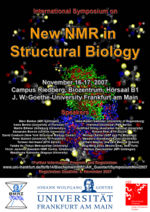News
From GuentertWiki
(Difference between revisions)
(→Press release Pannenhilfe der Antibiotikumproduktion entschlüsselt (11.08.2008)) |
|||
| Line 27: | Line 27: | ||
:Dr. Iwai will present two new approaches of segmental isotopic labelling and fractional <sup>13</sup>C labelling for NMR assignments of proteins. Recently, he has developed a robust approach for segmental isotopic labelling using protein trans-splicing, which could open possibilities to study a domain of intact proteins without dissecting into smaller globular domains. He will also present a novel concept to classify residue types in NMR spectra by the use of fractional labeling, which is distinct from routinely used chemical shifts and spin topologies for identifying residue types. | :Dr. Iwai will present two new approaches of segmental isotopic labelling and fractional <sup>13</sup>C labelling for NMR assignments of proteins. Recently, he has developed a robust approach for segmental isotopic labelling using protein trans-splicing, which could open possibilities to study a domain of intact proteins without dissecting into smaller globular domains. He will also present a novel concept to classify residue types in NMR spectra by the use of fractional labeling, which is distinct from routinely used chemical shifts and spin topologies for identifying residue types. | ||
| − | ===== Press release | + | ===== Press release (11.08.2008) ===== |
| + | |||
| + | Pannenhilfe der Antibiotikumproduktion entschlüsselt | ||
:[http://www.volkswagenstiftung.de/service/aktuelles/archiv/period/1233149134///article/145/pannenhilfe.html Press release] by the [http://www.volkswagenstiftung.de/ Volkswagen Foundation]. | :[http://www.volkswagenstiftung.de/service/aktuelles/archiv/period/1233149134///article/145/pannenhilfe.html Press release] by the [http://www.volkswagenstiftung.de/ Volkswagen Foundation]. | ||
Revision as of 15:33, 28 January 2009
Contents |
2009
Seminar by Dr. Hélène Van Melckebeke (16.01.2009)
- High resolution structure of the HET-s(218-289) prion amyloid fibrils using solid-state NMR
- Dr. Hélène Van Melckebeke, Physical Chemistry, ETH Zürich, Switzerland
- Prions and amyloid fibrils are associated with several animal and human diseases. Despite the paramount importance of the structural aspects, no atomic resolution structure of a prion in its fibrillar state has been reported yet. Solid-state NMR is to date the only technique capable of obtaining the structure of such non-crystalline and non-soluble compounds. We have obtained the structure of amyloid fibrils produced in vitro from the prion-forming domain (residues 218-289) of the HET-s prion from the filamentous fungus Podospora anserina using solid-state NMR techniques. These results give a structural explanation of the stability of the HET-s(218-289) fibrils. In the presentation, both methodological and structural aspects will be discussed.
- Wasmer, C. Lange, A., Van Melckebeke, H., Siemer, A. B., Riek, R. & Meier, B. H. (2008). Amyloid fibrils of the HET-s(218–289) prion form a β solenoid with a triangular hydrophobic core. Science 319, 1523–1526.
2008
Seminar by Prof. Masatsune Kainosho (14.10.2008)
- Recent progress in the SAIL approach to study side-chain conformations of proteins and protein complexes
- Prof. Dr. Masatsune Kainosho, Nagoya University and Tokyo Metropolitan University, Japan
Seminar by Dr. Hideo Iwai (15.09.2008)
- Segmental and fractional isotopic labelling of proteins
- Dr. Hideo Iwai, University of Helsinki, Finland
- Dr. Iwai will present two new approaches of segmental isotopic labelling and fractional 13C labelling for NMR assignments of proteins. Recently, he has developed a robust approach for segmental isotopic labelling using protein trans-splicing, which could open possibilities to study a domain of intact proteins without dissecting into smaller globular domains. He will also present a novel concept to classify residue types in NMR spectra by the use of fractional labeling, which is distinct from routinely used chemical shifts and spin topologies for identifying residue types.
Press release (11.08.2008)
Pannenhilfe der Antibiotikumproduktion entschlüsselt
- Press release by the Volkswagen Foundation.
Seminar by Prof. Koichi Kato (03.07.2008)
- NMR and sugar library approaches for structural glycomics
- Prof. Dr. Koichi Kato, Nagoya City University, Nagoya, and Institute of Molecular Science, Okazaki, Japan
- Many proteins in the living systems are covalently linked to carbohydrate moieties. NMR spectroscopy can potentially provide information on the structure and dynamics of glycoproteins in solution but has also been hampered by spectral overlap and low sensitivity. To cope with this difficulty, we have been developing a systematic method for structural glycobiology by combined use of stable-isotope-assisted NMR spectroscopy and multi-dimensional HPLC techniques for glycosylation profiling and sugar library construction. Our projects address the underlying mechanisms of
- Glycoform-dependent effector functions of immunoglobulin G glycoproteins as therapeutic antibodies
- Glycoprotein-fate determination in cells through the interactions with a variety of intracellular lectins
2007
Symposium on New NMR in Structural Biology 2007 (16-17.11.2007)
- Center for Biomolecular Magnetic Resonance (BMRZ), Cluster of Excellence Frankfurt Macromolecular Complexes, Johann Wolfgang Goethe-University Frankfurt am Main
